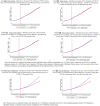Risk avoidance, offsetting community effects, and COVID-19: Evidence from an indoor political rally
- PMID: 34720400
- PMCID: PMC8535106
- DOI: 10.1007/s11166-021-09359-4
Risk avoidance, offsetting community effects, and COVID-19: Evidence from an indoor political rally
Abstract
The Centers for Disease Control and Prevention (CDC) deem large indoor gatherings without social distancing the "highest risk" activity for COVID-19 contagion. On June 20, 2020, President Donald J. Trump held his first mass campaign rally following the US coronavirus outbreak at the indoor Bank of Oklahoma arena. In the weeks following the event, numerous high-profile national news outlets reported that the Trump rally was "more than likely" the cause of a coronavirus surge in Tulsa County based on time series data. This study is the first to rigorously explore the impacts of this event on social distancing and COVID-19 spread. First, using data from SafeGraph Inc, we show that while non-resident visits to census block groups hosting the Trump event grew by approximately 25 percent, there was no decline in net stay-at-home behavior in Tulsa County, reflecting important offsetting behavioral effects. Then, using data on COVID-19 cases from the CDC and a synthetic control design, we find little evidence that COVID-19 grew more rapidly in Tulsa County, its border counties, or in the state of Oklahoma than each's estimated counterfactual during the five-week post-treatment period we observe. Difference-in-differences estimates further provide no evidence that COVID-19 rates grew faster in counties that drew relatively larger shares of residents to the event. We conclude that offsetting risk-related behavioral responses to the rally-including voluntary closures of restaurants and bars in downtown Tulsa, increases in stay-at-home behavior, displacement of usual activities of weekend inflows, and smaller-than-expected crowd attendance-may be important mechanisms.
Supplementary information: The online version contains supplementary material available at 10.1007/s11166-021-09359-4.
Keywords: COVID-19; Indoor events; Offsetting behavioral effects; Risk avoidance; Social distancing; Trump.
© The Author(s), under exclusive licence to Springer Science+Business Media, LLC, part of Springer Nature 2021.
Figures






Similar articles
-
The contagion externality of a superspreading event: The Sturgis Motorcycle Rally and COVID-19.South Econ J. 2021 Jan;87(3):769-807. doi: 10.1002/soej.12475. Epub 2020 Dec 2. South Econ J. 2021. PMID: 33362303 Free PMC article.
-
Political violence, risk aversion, and population health: Evidence from the US Capitol riot.J Popul Econ. 2022;35(4):1345-1384. doi: 10.1007/s00148-022-00914-0. Epub 2022 Jul 14. J Popul Econ. 2022. PMID: 35855728 Free PMC article.
-
Nail in the Coffin or Lifeline? Evaluating the Electoral Impact of COVID-19 on President Trump in the 2020 Election.Polit Behav. 2022 Oct 23:1-29. doi: 10.1007/s11109-022-09826-x. Online ahead of print. Polit Behav. 2022. PMID: 36311381 Free PMC article.
-
Death by political party: The relationship between COVID-19 deaths and political party affiliation in the United States.World Med Health Policy. 2021 Jun;13(2):224-249. doi: 10.1002/wmh3.435. Epub 2021 May 5. World Med Health Policy. 2021. PMID: 34226856 Free PMC article.
-
Social distancing policies in 22 African countries during the COVID-19 pandemic: a desk review.Pan Afr Med J. 2020 Dec 14;37(Suppl 1):46. doi: 10.11604/pamj.supp.2020.37.46.27026. eCollection 2020. Pan Afr Med J. 2020. PMID: 33552374 Free PMC article. Review.
Cited by
-
To vote, or not to vote? Electoral campaigns and the spread of COVID-19.Eur J Polit Econ. 2022 Mar;72:102118. doi: 10.1016/j.ejpoleco.2021.102118. Epub 2021 Sep 16. Eur J Polit Econ. 2022. PMID: 35317430 Free PMC article.
-
Comparing the impact on COVID-19 mortality of self-imposed behavior change and of government regulations across 13 countries.Health Serv Res. 2021 Oct;56(5):874-884. doi: 10.1111/1475-6773.13688. Epub 2021 Jun 28. Health Serv Res. 2021. PMID: 34182593 Free PMC article.
-
The Impact of the first COVID-19 shelter-in-place announcement on social distancing, difficulty in daily activities, and levels of concern in the San Francisco Bay Area: A cross-sectional social media survey.PLoS One. 2021 Jan 14;16(1):e0244819. doi: 10.1371/journal.pone.0244819. eCollection 2021. PLoS One. 2021. PMID: 33444363 Free PMC article.
-
Do more stringent policies reduce daily COVID-19 case counts? Evidence from Canadian provinces.Econ Anal Policy. 2023 Jun;78:225-242. doi: 10.1016/j.eap.2023.03.006. Epub 2023 Mar 8. Econ Anal Policy. 2023. PMID: 36941918 Free PMC article.
-
A decision-making framework for COVID-19 infodemic management strategies evaluation in spherical fuzzy environment.Stoch Environ Res Risk Assess. 2023;37(4):1635-1648. doi: 10.1007/s00477-022-02355-3. Epub 2023 Jan 20. Stoch Environ Res Risk Assess. 2023. PMID: 36714449 Free PMC article.
References
-
- Abadie A, Diamond A, Hainmueller J. Synthetic control methods for comparative case studies: Estimating the effect of California’s tobacco control program. Journal of the American Statistical Association. 2010;105(490):493–505. doi: 10.1198/jasa.2009.ap08746. - DOI
-
- Abouk, R., & Heydari, B. (2020). The immediate effect of COVID-19 policies on social distancing behavior in the United States (SSRN Scholarly Paper No. ID 3571421). Social Science Research Network, Rochester, NY 10.2139/ssrn.3571421
-
- Ahammer, A., Halla, M., & Lackner, M. (2020). Mass gatherings contributed to early COVID-19 mortality: Evidence from US Sports. Working Paper. http://www.economics.jku.at/papers/2020/wp2013.pdf. Accessed 15 Aug 2020
-
- Andersen, M., Maclean, J.C., Pesko, M.F., & Simon, K.I. (2020). Effect of a federal paid sick leave mandate on working and staying at home: Evidence from cellular device data (Working Paper No. 27138), Working Paper Series. National Bureau of Economic Research. 10.3386/w27138
LinkOut - more resources
Full Text Sources
